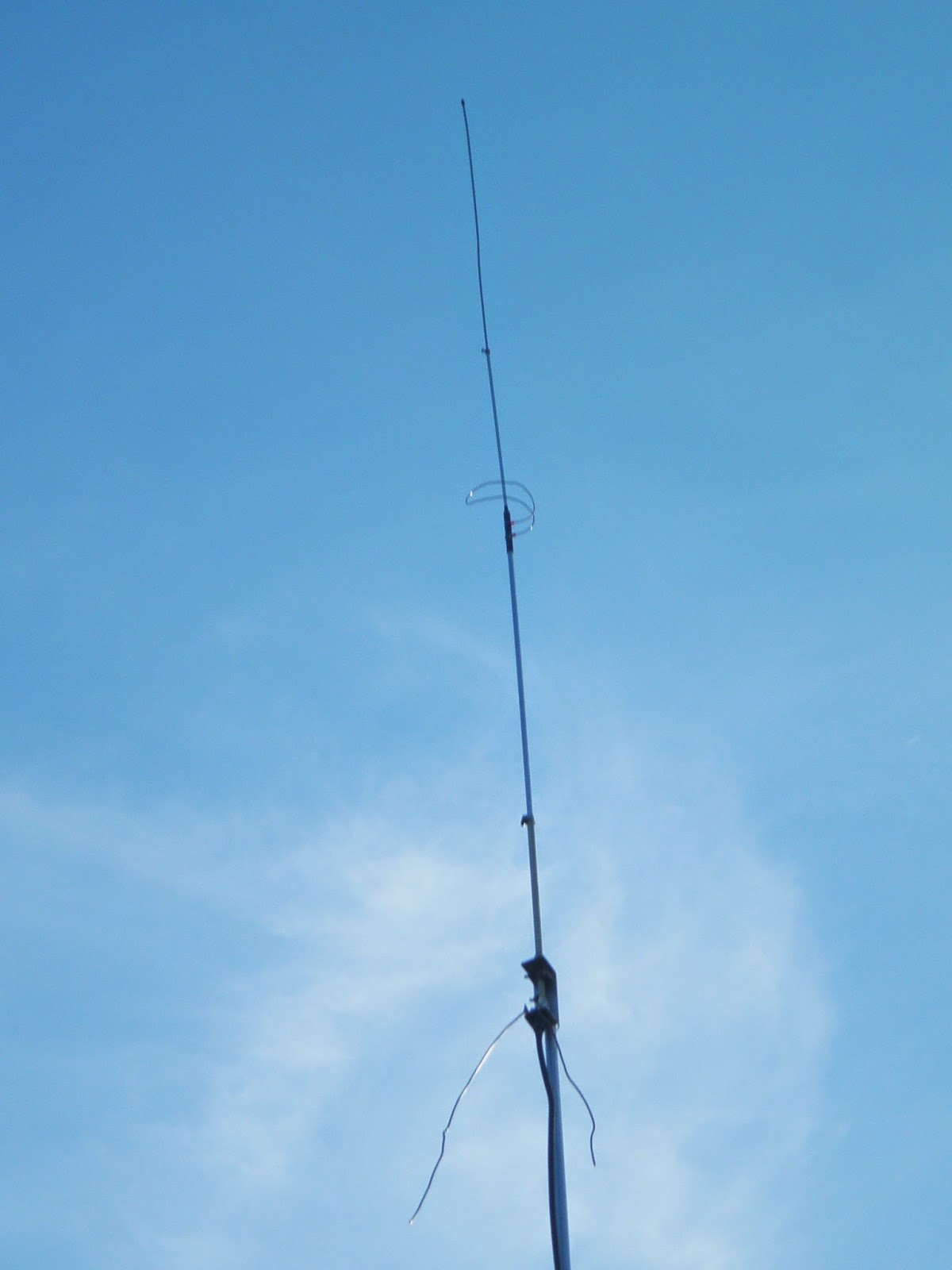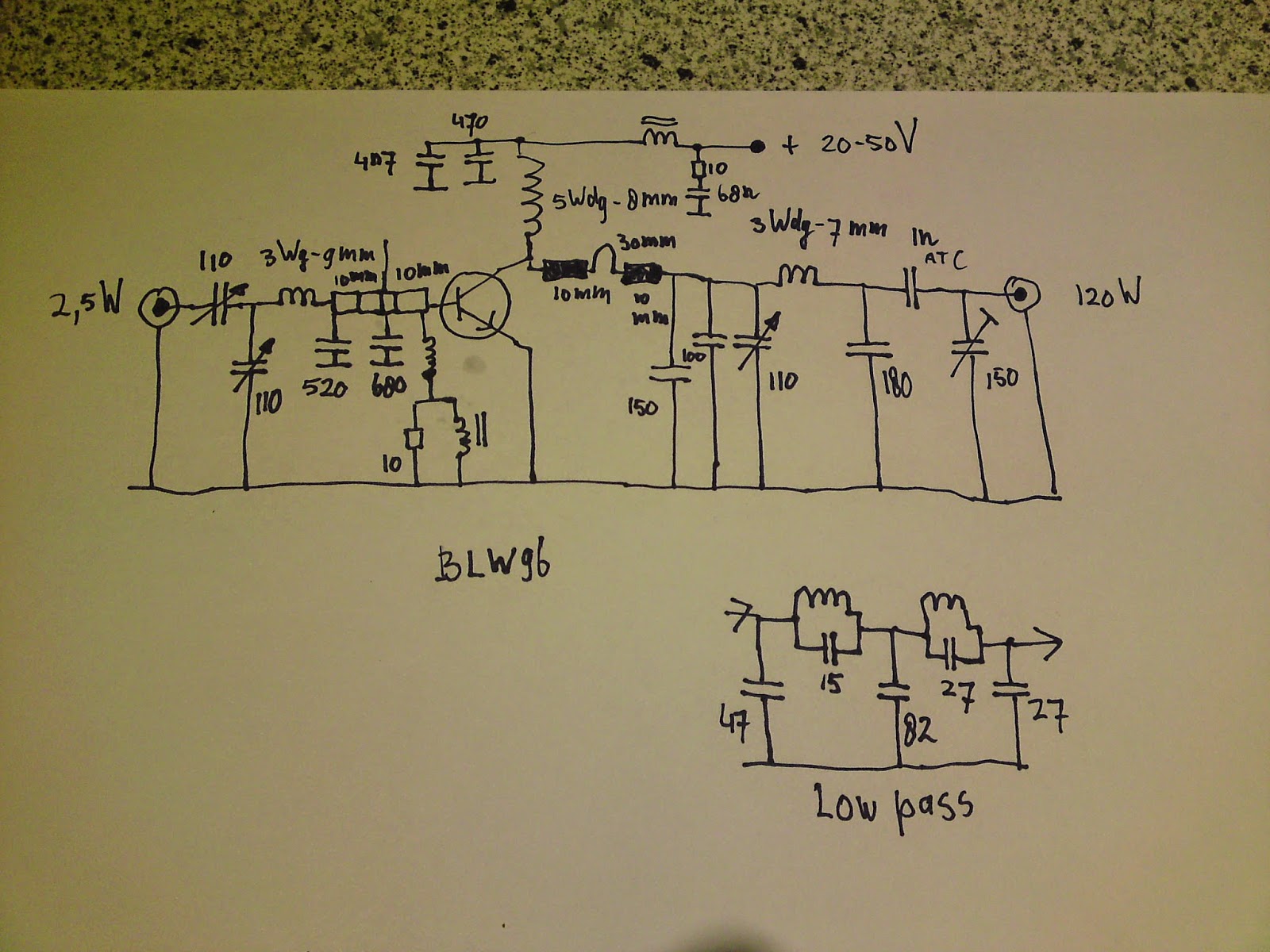Inleiding:
Om eens een lichte dualband trap vertical te maken voor 50 én 70 Mhz, heb ik het volgende ontworpen.
De voordelen zijn o.a.:
* geen lange radialen nodig
* slechts één straler, die efficiënt wordt benut.
* weinig windvang en licht van gewicht.
* voeding via één kabel.
Achtergrond van het ontwerp:
Tot nu gebruikte ik een vertical met twee paralelle stralers en een zijarm. Dit werkte maar had meer windvang en deze had geen rond diagram. Het idee was iets lichters te bouwen, gebaseerd op het hi-endfed principe. Dus hoogohmig voedingspunt en geen radialen, althans geen lange.
Verloop van de design:
Eerst werd een 1/2 golf vertical voor 70 Mhz gemaakt en aangepast. Hierbij bleek 1.85 m de hoogste impedantie te geven. Slechts een serie-spoel van ca. 530 nH bleek voldoende voor SWR 1:1. Dit komt omdat de bevestiging van het onderste 12 cm van de straler een stukje transmissielijn vormt van ca. 100 ohm. Dit komt neer op een parallel-capaciteit van ca. 6 pf. Dit vormt samen met de spoel een impedantie-trafo van 50 naar ca. 700 ohm.
Hetzelfde werd gedaan op 50 Mhz; hierbij bleek 2.70 m de beste waarde. De spoel moest echter iets groter zijn, ca. 580 nH. Én er bleek een C van straler naar massa nodig van ca. 5 pf.
De antenne heeft een trap met een C van 9 pf. Deze moet op 70 mhz een sperkring vormen. De parallel C bestaat uit 9 cm RG-213.
Deze kring vormt op 50 mhz een verlengspoel. Daarom moet het stukje hierboven kleiner zijn dan bij de normale halve golf. 50 cm bleek de beste waarde.
De antenne heeft een aanpassing die op beide banden een goede SWR geeft.
Op beide banden is de voeding hoogohmig, ca. 700 ohm; echter niet helemaal gelijk zeker niet qua imaginaire component.
Na wat gepuzzel met een Smith-chart programma en daarna een los antenne-tunertje werd de juiste aanpassing gevonden. Twee spoelen en een serie C van 39 pf.
Ik heb verder twee radialen van 100 cm staaldraad gebruikt. Dit om mantelstromen te elimineren en toch altijd enig tegenwicht te hebben.
Grote spoel: 8 wdg op 11 mm boor gewikkeld; Kleine spoel: 9 wdg op 7 mm boor gewikkeld. C is 39 pf.
links de 6+4 m vertical.
Ik heb verder twee radialen van 100 cm staaldraad gebruikt. Dit om mantelstromen te elimineren en toch altijd enig tegenwicht te hebben.
Constructie details:
Voor de bevestiging heb ik een aluminium plaatje van 2 mm dik en 5 x 25 cm gebruikt. Hierin moeten eerst de gaten van ca. 16 mm voor de straler en de SO-239 of de aansluitdoos geboord worden. En de m3 gaatjes voor boutjes.
Hierna moet deze haaks worden gebogen zodat het onderste deel 5x5 cm wordt.
Het bovenste deel kan 4x5 cm worden.
Het bovenste deel kan 4x5 cm worden.
De straler loopt door een hostaliet buis van 5/8 (= ca. 16 mm) en 30 cm lang. Aan de bovenkant is deze waterdicht afgesloten met een stukje krimpkous.
Onderaan is de straler met een U-klemmetje bevestigd op een stukje nylon van 1 cm dik. Ook voor de mastbevestiging zijn m4 U-klemmetjes gebruikt.
Onderaan is de straler met een U-klemmetje bevestigd op een stukje nylon van 1 cm dik. Ook voor de mastbevestiging zijn m4 U-klemmetjes gebruikt.
De antenne kan op een dunne mast geplaatst worden. Bij mij is het bovenste mast-deel slechts 16 mm x 70 cm. Deze staat weer in 20 mm buis en deze weer in 25 mm buis.
Dus een soort telescopische mast.
Resultaten:
De antenne werkt prima ! Op 1,5 m boven de grond werd de aanpassing afgesteld op 1:1 op beide banden.
In de mast geplaatst bleek de SWR op zowel 50 als 70 mhz 1,2 te zijn.
De antenne blijkt ook breedbandig te zijn. Dit was te verwachten want er treden geen hoge Q 's op in de aanpassing. Van ca. 40 Mhz tot 52 Mhz werkt de aanpassing goed en ook van ca. 65 tot 73 mhz is dit het geval. Uiteindelijk heb ik de aanpassing in een dichte behuizing gemaakt.
 |
| First test with open air coils. The matching circuit is the most critical part of the antenna. But one time adjusted, it works even in rain when using the right housing. |
Grote spoel: 8 wdg op 11 mm boor gewikkeld; Kleine spoel: 9 wdg op 7 mm boor gewikkeld. C is 39 pf.
links de 6+4 m vertical.
Detail van de constructie. De straler loopt voor de eerste 12 cm lengte op een afstand van 1 cm van het plaatje. Dit is belangrijk want dit is een een capaciteit van ca. 6 pf. Ofwel een stukje transmissielijn van ca. 100 ohm.
Testing another match with big coil-diameters in open air
 |
| Checking swr on 6 and 4 m |
 |
| Tuning the dual band match in Alum box |
 |
| Waterproof housing. PVC tube still to be extended .. |
 |
| Improvement against rain with extended PVC tube. Now swr remains ok. Also the distance between the feedpoint bolt and U-clamp (=earth) is enlarged |
 |
 |
| First test. Small 50 V capacitor exploded.. |
English:
Dual band
half wave trap vertical antenna for 50 and 70 Mhz
Introduction:
To build a
lightweight dualband trap vertical for
50 and 70 Mhz, I made the following design.
Benefits
are :
* No long
radials needed
* Only one
radiator, which is utilized efficiently.
* Little
windage and lightweight.
* Feeding
via a single cable.
Background of
the design:
Until now I
used a vertical with two parallel elements and a side arm. This worked but had more
windload and it didn’t have a circular radiation pattern. The idea was to build
something lighter, based on the hi-endfed principle. So high impedance feed
point and no radials, at least not long ones.
Development of the design :
First, a
half wave vertical for 70 Mhz was built and tested. I found out that 1.85 m
gave the highest impedance. Only one
series-coil of approximately 530 nH proved sufficient for SWR 1: 1. This was
because the lower 12 cm of the radiator,
equals a piece of transmission line of approximately 100 ohms. This equates to
a parallel capacity of about 6 pf. This, together with the coil forms an
impedance transformer from 50 to about 700 ohms.
The same
was done at 50 MHz; here 2.70 m proved to be the best length. The coil had to be slightly
larger, approximately 580 nH. And there was an extra C to ground needed of about 5 pf.
The antenna
has a trap with a C of 9 pf. This forms an LC parallel circuit on 70 mhz . Parallel C
consists of 9 cm RG-213.
The trap acts
as an extension coil on 50 mhz.
Therefore, the top part must be shorter
than in the a normal half-wave. 50 cm proved to be the best value.
The antenna
has a matching circuit that gives good SWR on both bands.
On both
bands the feedpoint has a high impedance, about 700 ohms; But not exactly the same, certainly not in
terms of imaginary component.
After some
triels with a Smith chart program and then a separate antenna ATU the right adjustment
was found. Two coils and the series C of 39 pf.
I’ve also
have applied two radials of 100 cm steel
wire . Just to make sure counterpoise and to avoid common-mode currents on the cable.
Constructional
details:
For the
attachment I’ve used a small aluminium
plate of 2 mm thick and 5 x 25 cm. First there must be
drilled some holes. One of approximately 16 mm for the radiator and the SO-239
or the terminal box and m3 /m4 holes for the bolts.
After this,
it must be bent 90 degrees so that the lower part is 5x5 cm. Perpendicular .
The upper
part can be 4x5 cm.
The
radiator goes through a hostalite 5/8 tube (= approx. 16 mm Ø) and 30 cm long. At the
bottom of the radiator it is attached with a U-clamp.
The lower
part is attached on a piece of 1 cm thick nylon. Also for the mast fixing m4 U-clamps are used.
The antenna
can be placed on a thin mast. In my case, the top mast section is only 16 mm x
70 cm. This is again in a 20 mm tube and this one in a 25 mm tube. So a kind of
telescopic mast.
Results:
The antenna
works fine! 1.5 m above the ground alignment was adjusted to SWR 1: 1 in both
bands.
Placed in
the mast the SWR appeared to be 1.2 on both bands .
The antenna
also appears to be wide band .This was expected because there isn’t a high Q
in the matching circuit. From about 47 Mhz till 52 Mhz it is working
properly, and also between 65 to 73 MHz. Later I made a
variation with large diameter coils and fewer turns. As a result, the effect of
rain is reduced on the swr. Later I
added a waterproof housing with was another improvement.
















































